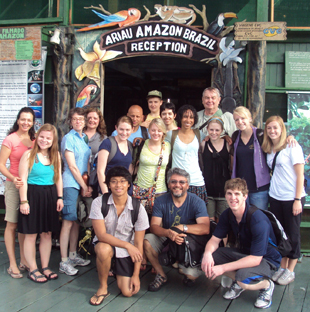June 7, 2011
Development, environment and creative writing in the Amazon Rain Forest

K-State faculty members recently led 13 students on a study abroad trip called Development, Environment and Creative Writing in the Brazilian Rain Forest.
In the last few decades the Amazon region has attracted a lot of attention as home to one of the last large rain forests in the world and for the transformations being caused by regional economic change.
The study abroad course was lead by Marcellus Caldas from geography, Martha Smith-Caldas from the Division of Biology, and Elizabeth Dodd from English. The program promotes the understanding of how people live in the Brazilian Amazon region and focused on reconciling regional economic development with environmental sustainability.
Through various field excursions, readings, lectures and discussions, the K-State students considered how the need to provide livelihoods for local people could be met while at the same time protecting a global resource, the Amazon Rain Forest.
The program took place in the Brazilian portion of the Amazon Basin, specifically in the cities of Manaus in the Amazonas state, and Belém in the state of Pará.
It began in Manaus, with several days of initial lectures and excursions in the Ariaú Ecological Resort. The Ariaú is a treetop hotel located two hours by boat from Manaus in the Ariaú River, one of the Amazon River’s many tributaries. Activities in this part of the trip included a boat trip on the Amazon River; swimming with rare pink dolphins; trekking through the rain forest; and alligator spotting. These activities let the students to interact with local people and visit the rain forest and various other locations that demonstrate the tension of reconciling environmental protection with economic development.
In the city of Manaus, the students visited the National Institute of Amazonian Research — one of the most important research institutes in Latin America — and the Executive Commission for Cocoa Planning. They interacted with local researchers and visited experimental stations. Also while in Manaus, students visited the opera house, the fish market and museums.
The next stop was Belém, one of Brazil's busiest ports, about 60 miles upriver from the Atlantic Ocean. Belém was built on a number of small islands intersected by channels and other rivers. Students compared the development of Manaus and Belém, the two largest cities in the Amazon. Belém houses the famous Goeldi Museum with its world-famous ethnological and zoological collections. The zoological-botanical garden shelters manatees, alligators, snakes, monkeys, birds and other Amazonian animals. In addition, the trip continued for some days in the fantastic fauna and flora of Marajó Island, one of the largest fluvial islands in the world.
